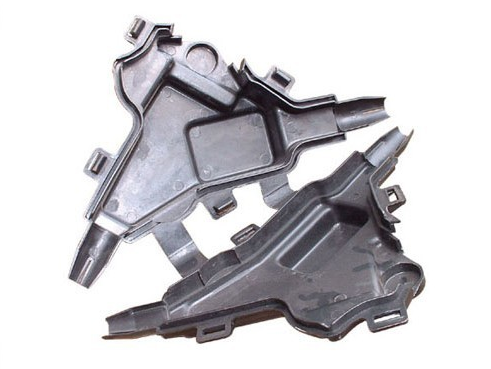1)抗拉强度和屈服强度
1) Tensile strength and yield strength
不同类型的模具对锻造模具材料所要求的力学性能具体指标有所侧重,同时不应仅考虑室温力学性能而忽视更重要的实际工作温度的性能指标;切忌追求盲目脱离实际的高指标。例如:在冷锻变形抗力极高的难变形合金锻件时,当模具承受的应力超过锻造模具材料在使用温度下的抗拉强度时,会导致模具开裂报废;如果模具承受的应力超过锻造模具材料在使用温度下的屈服强度时,则会引起模具塌陷等变形,导致锻件超差。在这种条件下,就要选择抗拉强度和屈服强度高的锻造模具材料,一般,锻造模具材料的抗拉强度应大于应承受应力的30%以上。
Different types of dies focus on the specific mechanical properties required by forging die materials. At the same time, we should not only consider the mechanical properties at room temperature and ignore the more important performance indexes at actual working temperature; Do not pursue comprehensive high indicators that are blindly divorced from reality. For example, in the case of hard to deform alloy forgings with high cold forging deformation resistance, when the stress borne by the die exceeds the tensile strength of the forging die material at the service temperature, the die will be cracked and scrapped; If the stress borne by the die exceeds the yield strength of the forging die material at the service temperature, permanent deformation such as die collapse will be caused, resulting in out of tolerance of the forging. Under this condition, forging die materials with high tensile strength and yield strength should be selected. Generally, the tensile strength of forging die materials should be greater than 30% of the stress.
2)冲击韧性、断面收缩率和延伸率
2) Impact toughness, reduction of area and elongation
由于锻造模具材料的冲击韧性指标的选择与锻造载荷性质密切相关,因此,对于锻锤和螺旋压力机等冲击载荷设备使用的模具,如果锻造模具材料的冲击韧性低,模具有可能发生开裂而报废;在这种条件下,就要选择冲击韧性高的锻造模具材料。
Because the selection of impact toughness index of forging die material is closely related to the properties of forging load, for the dies used by impact load equipment such as forging hammer and screw press, if the impact toughness of forging die material is low, the dies may crack and be scrapped; Under this condition, forging die materials with high impact toughness should be selected.
对于断面收缩率和延伸率高的锻造模具材料,可以在出现微小裂纹的情况下继续使用,而不致于很快就破裂,因此,在抗拉强度、屈服强度和硬度指标许可条件下,尽可能地提高其断面收缩率和延伸率。

For forging die materials with high area shrinkage and elongation, they can continue to be used in the case of small cracks without breaking soon. Therefore, under the permission of tensile strength, yield strength and hardness indexes, the area shrinkage and elongation shall be improved as much as possible.
3)硬度
3) Hardness
鉴于硬度除了与强度指标有对应关系外,还与模具的耐磨性密切相关,在冲击韧性、断面收缩率和延伸率等指标许可条件下,尽可能地提高其硬度(或耐磨性)。锻模硬度和红硬性是锻模材料的重要性能,模具在高温下工作应能保持其形状和尺寸不发生变化。
In view of the fact that the hardness is not only related to the strength index, but also closely related to the wear resistance of the die, the hardness (or wear resistance) shall be improved as much as possible under the allowable conditions of impact toughness, reduction of area and elongation. The hardness and red hardness of forging die are important properties of forging die materials. The die should be able to keep its shape and size unchanged when working at high temperature.
众所周知,同一个锻造模具材料的抗拉强度、屈服强度、硬度和断面收缩率、延伸率、冲击韧性之间存在着相互矛盾的关系,如果提高前者,必须要牺牲后者,这就需要根据具体模具的实际工作环境来选择相应的性能匹配。
As we all know, there is a contradictory relationship between the tensile strength, yield strength, hardness, reduction of area, elongation and impact toughness of the same forging die material. If the former is improved, the latter must be sacrificed, which requires the corresponding performance matching to be selected according to the actual working environment of the specific die.
必须指出,材料的硬度在一定程度不但可以反映强度水平,而且硬度和耐磨性有着甘种对应关系,一般硬度高的材料,其耐磨性也好,因此,许多锻造模具材料通常只简单地规定对硬度的要求。
It must be pointed out that the hardness of materials can not only reflect the strength level to a certain extent, but also have a corresponding relationship between hardness and wear resistance. Generally, materials with high hardness have good wear resistance. Therefore, many forging die materials usually only simply specify the requirements for hardness.
2.疲劳性能
2. Fatigue performance
锻造模具材料的疲劳性能包括机械疲劳和冷热疲劳两种。热作模具长期在高机械载荷零机械载荷及200℃~600℃温度区间交替循环,这两种脉冲的加载和卸载所造成应力的叠加,久而久之,模膛表面会萌生出微裂纹;微裂纹进一步发展就会加速模具磨损、产生碎块,从而导致模具失效,所以要求锻造模具材料应该具有良好的抗机械疲劳和抗冷热疲劳性能。
The fatigue properties of forging die materials include mechanical fatigue and cold and hot fatigue. The hot working die circulates alternately from high mechanical load to zero mechanical load and 200 ℃ ~ 600 ℃ temperature range for a long time. The superposition of stress caused by loading and unloading of these two pulses will cause microcracks on the surface of the die bore over time; The further development of microcracks will accelerate die wear and produce fragments, resulting in die failure. Therefore, it is required that the forging die material should have good mechanical fatigue resistance and cold and hot fatigue resistance.
